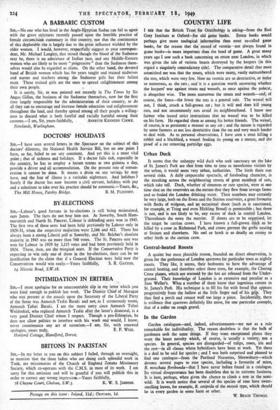COUNTRY LIFE
I sea that the British Trust for Ornithology is asking—from the Earl Grey Institute at Oxford—for old game books. Estate books would perhaps give more zoological information than most so-called game books, for the reason that the- record of vermin—not always found in game books—is more important than the head of game. A great many years ago I saw such a book concerning an estate near London, in which was given the tale of various beasts destroyed by the keepers (in this regard a singularly contradictory title). The comparative detail that most astonished me was that the stoats, which were many, vastly outnumbered the rats, which were very few. Now no vermin are so destructive, or today so numerous, as the rats ; and it is a question worth answering whether the keepers' war against stoats and weasels, as once against the polecat, is altogether wise. The more numerous the stoats and weasels—and, of course, the foxes—the fewer the rats is a general rule. The weasel will not, I think, attack a full-grown rat ; but it will and does kill young rats, and not uncommonly rats avoid its neighbourhood. I know one farmer who issued strict instructions that no weasel was to be killed on his farm. He regarded them as among his better friends. The weasel, of course, is as persistent a mouser as any cat ; and the mouse is regarded by some farmers as not less destructive than the rat and very much harder to deal with. As to personal observations, I have seen a stoat killing a rabbit and a blackbird, a weasel feeding its young on a mouse, and the proof of a rat removing partridge eggs.






































 Previous page
Previous page